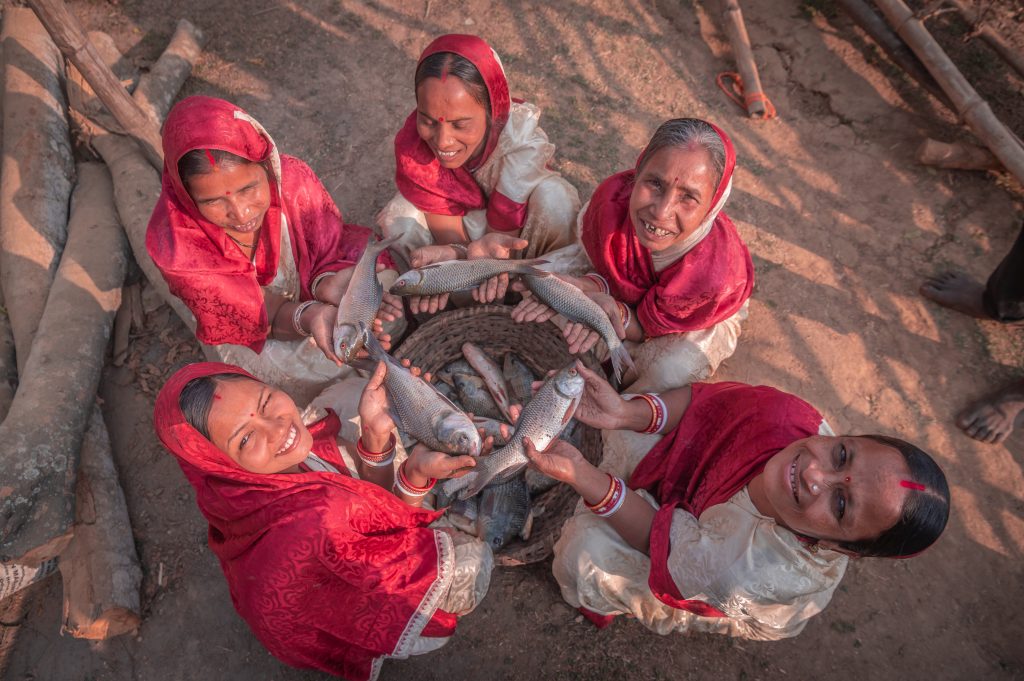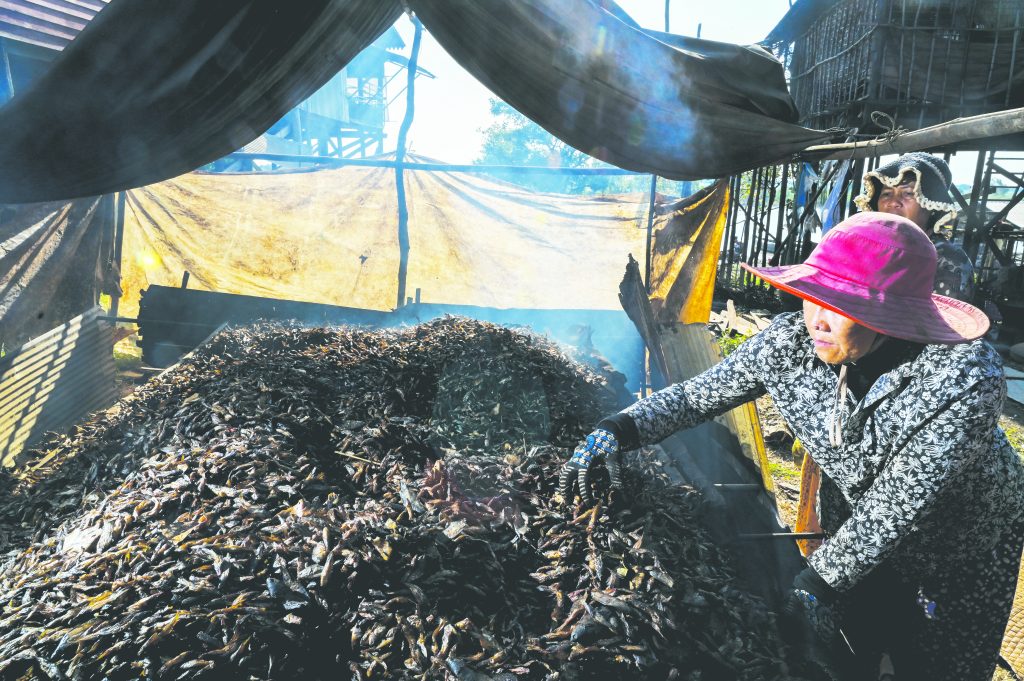A cooperative action plan currently under draft aims to address labour and entrepreneurship challenges for women in fisheries
By Surendran Rajaratnam (surendran@ukm.edu.my), Lecturer, UniversitiKebangsaan, Malaysia
Gender inequality is one of the most pressing barriers in the fisheries sector’s labour market. Women workers in Asian fish value chains constitute a large share of the world’s fishworkers. In addition to their productive activities, these women are responsible for reproductive activities/unpaid work within their households and communities. However, they face numerous challenges to participating in and benefiting from the sector. Furthermore, the social and economic issues women face in the fisheries and aquaculture sector tend to receive little or no attention.
With this in mind, prior to the 29 November 2021 webinar ‘Women Work in Fisheries, Too!’, the Gender in Aquaculture and Fisheries Section of the Asian Fisheries Society (GAFS), in collaboration with US Agency for International Development Sustainable Fish Asia Local Capacity Development (USAID SUFIA LCD) activity, convened a team of experts to develop the first draft of ‘Decent Work and Thriving Businesses for Women in Fisheries: A Cooperative Action Plan’. The objective of the Cooperative Action Plan is to provide guidance to fisheries stakeholders/entities in the Asia-Pacific region on actions to improve women’s access to gender-just, equitable and inclusive labour conditions.

The Cooperative Action Plan begins by identifying and planning to address contemporary issues pertaining to gender and labour in the Asian fisheries and aquaculture sector. The action plan is targeted at steps that individuals and organisations working in the sector can take in the next five years. The first draft was revised by the expert writing team and partners and will be subject to wider consultation, especially from the participants of the webinar, before being finalised and published.
The Cooperative Action Plan aims for women working in the sector to be given attention, voice, and strong representation in decision making roles in policy, sector bodies, and business. It also highlights the interests and contributions of youth and vulnerable groups of women and aims for them to be represented in policy and decision making. Sex-disaggregated and gender data, as well as data on intersectional factors, needs to be collected to inform research and development conducted in the sector. Finally, it also seeks for actions relating to illegal, unreported and unregulated fishing, management and changes in the value chain, climate change, and the COVID-19 pandemic to be taken into consideration and incorporated in recovery programmes, policies, and interventions.
There are three clusters of articles in the action plan: 1) Domains of Fisheries Labour, 2) Groups Frequently Overlooked, and 3) Cooperative Action for Change. Within each of the clusters, there are several articles or thematic areas.
This first article, ‘Domains of Fisheries Labour’ covers the themes of small-scale fishery value chains, industrial fishery value chains, reproductive and care labour, fisheries management, public and private sector management, research and monitoring.
The outcomes sought in small-scale fishery value chains are to forge greater formal recognition that leads to improved labour conditions for women and improves the uptake of gender equality provisions of the Voluntary Guidelines for Securing Sustainable Small-Scale Fisheries in the Context of Food Security and Poverty Eradication (the SSF Guidelines). These outcomes will be achieved through raising awareness and formal recognition of the productive roles of women in small-scale fisheries (SSF), strengthening protection for women in SSF and enabling them to have a voice in all processes within the sector. There are also plans to formally recognise women’s SSF labour as a legitimate fishing activity and for women to be provided with partnerships and programmes supporting technologies, skills, and linkages in post-harvest processing and trading nodes of the fish value chains.

In industrial fisheries, the dignity of labour for women workers, including migrant workers, involving decent working spaces and conditions is the main outcome targeted. This includes raising awareness on issues about women in industrial fisheries, strengthening the database of women and their work profiles, empowering women engaged in the industrial fish value chain labour market, and forging partnerships.
Reproductive and care labour aims for a promising and better quality of life for fisherwomen and the acceptance of women as equal partners in the development process and equal contributors within the household, workplace and community. These outcomes will be achieved through the collection of sex-disaggregated and gender data, the use of social change by working with fisher families, addressing harmful gender norms, and enabling women to take up leadership positions.
The fisheries management, public and private sector management, research and monitoring themes aim for women and men to have equal recruitment and promotion opportunities and outcomes and to be treated justly at work. To achieve this requires that gender equity policies are improved, organisations collect and publish sex-disaggregated and gender data, and commit to gender-budgeting.
The second article, ‘Groups Frequently Overlooked’, covers themes on young, elderly, and indigenous women.
Young women workers are expected to have safe working environments, free from any harassment, enabling their personal growth and development, and improved agency and well-being. These outcomes will be achieved through raising awareness on employability and creating safe and rewarding employment for young women and men. Improved capacities in entrepreneurship, empowering youth-led organisations, including start-ups and SMEs, and partnerships for youth-focused interventions were some of the activities proposed to achieve these outcomes.
On the theme of the elderly, it is envisioned that the sector will conduct assessments of the extent of work, welfare and social needs for elderly women and men. It will recognise their contributions and needs, and provide support accordingly to enable them to lead a dignified and productive life. These outcomes will be achieved through an assessment of numbers, locations, and needs of elderly women and men who are dependent on the sector. The theme further seeks to establish strengthened systems for social security for elderly women who are engaged in micro and small-scale value chains and for senior-preneurship for women in the fishing communities. It also recommends partnerships between government and civil societies that have expertise in working with the elderly for their productive aging.
The third theme in this cluster is indigenous women. The outcome sought is for indigenous women and men to have an equal opportunity in the sector to enable them to access resources, labour and entrepreneurial opportunities. It also expects indigenous people, especially women, to be equally represented in the policy-making processes. These outcomes will be achieved through the recognition and inclusion of indigenous women and their labour through reliable data. The theme also intends to draw attention to their labour and empower these women through their inclusion and representation in decision making bodies concerned with the fishery. Partnership among women’s groups would also be a means to network, share experience, and learn from
each other.
The third cluster, ‘Cooperative Action for Change’, covers themes on building the evidence base for action, collective action, and fisher organisation, and labour disruptions by human and natural disasters.
The theme on building the evidence base for action seeks reliable gender statistics on labour engagement for fish value chains and a quantum leap in the knowledge of women and men’s work, power, and gender relations affecting their labour opportunities and benefits. These can be achieved through developing and disseminating a handbook for collecting reliable gender statistics, strengthening social science research capabilities on women’s labour at all scales, institutions, and nodes of fish value chains. The commitments of research agencies are also crucial to generating the intended outcomes.
The next theme is collective action and fisher organisation. Its outcome seeks for enhanced participation and leadership of women fisher’s organisations and collective action in the sector as a pathway to decent work and access to social protection. These outcomes were intended to be achieved through the creation of fisherfolk, i.e., women’s collectives, through recognition of all fishing activities and formalisation of activities, strengthened representation of the collectives and organisations in state consultations, and the empowerment of women to enable their voices to be heard and for them to assume leadership positions in women’s and fisherfolk organisations. This theme also aims to reduce barriers to accessing social protection schemes for and establishing partnerships between fisherfolk organisations, women’s collectives and the State.
The third theme is on labour disruptions by human and natural disasters. During disaster recovery and rehabilitation, women’s labour and roles in the economy should be recognised and taken fully into account, their needs being represented in decision making, recovery budgeting and programming, as well as in monitoring progress. These outcomes will be achieved through the integration of women’s economic and care interests into planning and recovery efforts, with their rights and opportunities secured with post-emergency rehabilitation through gender responsive budgeting.
Other means to achieve the outcomes include strengthening opportunities for diversified livelihoods for women before, during and after emergencies. Households and community care will also be emphasised to ensure that greater than normal burdens do not fall on women, which could further impede their financial recovery. Women’s representation in emergency preparedness, through to recovery and rehabilitation, will be crucial to ensure partnerships are formed across government agencies, civil societies, the private sector, and other relevant groups.
The draft Cooperative Action Plan represents the opinions of gender in fisheries experts on the most appropriate short and medium term steps that organisations in the fisheries and aquaculture sector can take. Moving forward, the webinar participants and organising partners will develop a communication and dissemination plan to promote the actions shared above to achieve the outcomes within each of the articles and thematic areas. These will be widely promoted not only via press and on social media platforms but also through the participants and organising partners’ activities and research in the sector.
Fisherwomen from the Jai Hanuman Women’s self-help group with their freshly caught fish, Nuagaon Gram Panchayat, Odisha, India. Young women workers are expected to have safe working environments, free from any harassment, enabling their personal growth and development
Fish smoking near the Tonle Sap lake in Siem Reap, Cambodia. During disaster recovery and rehabilitation, women’s labour and roles in the economy should be recognised and taken fully into account
The objective of the Cooperative Action Plan is to provide guidance to fisheries stakeholders/entities in the Asia-Pacific region on actions to improve women’s access to gender just, equitable, and inclusive labour conditions